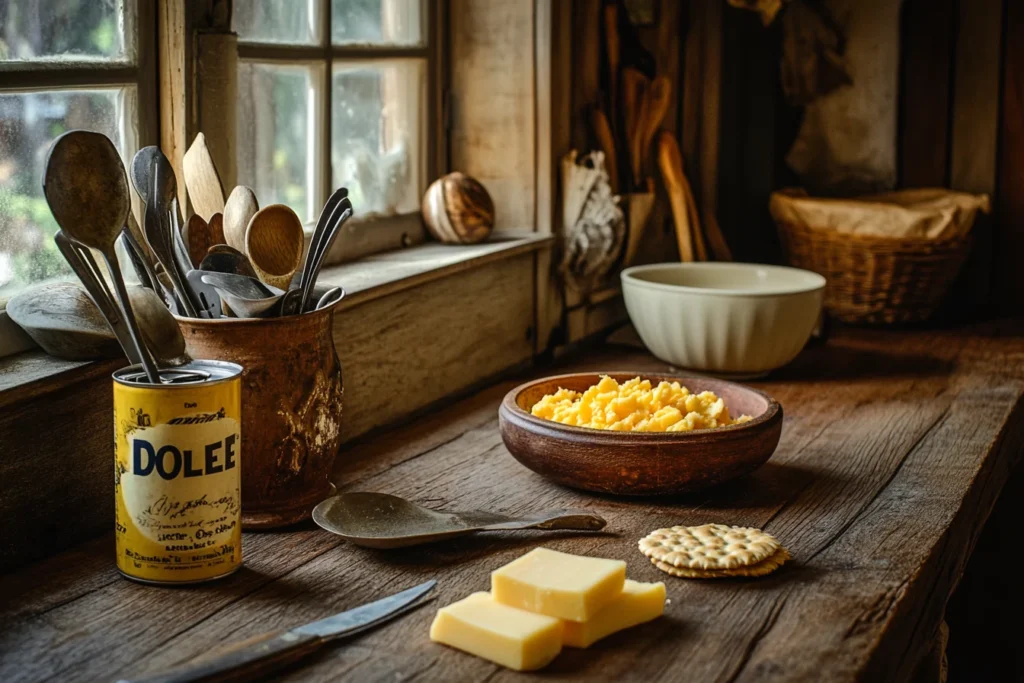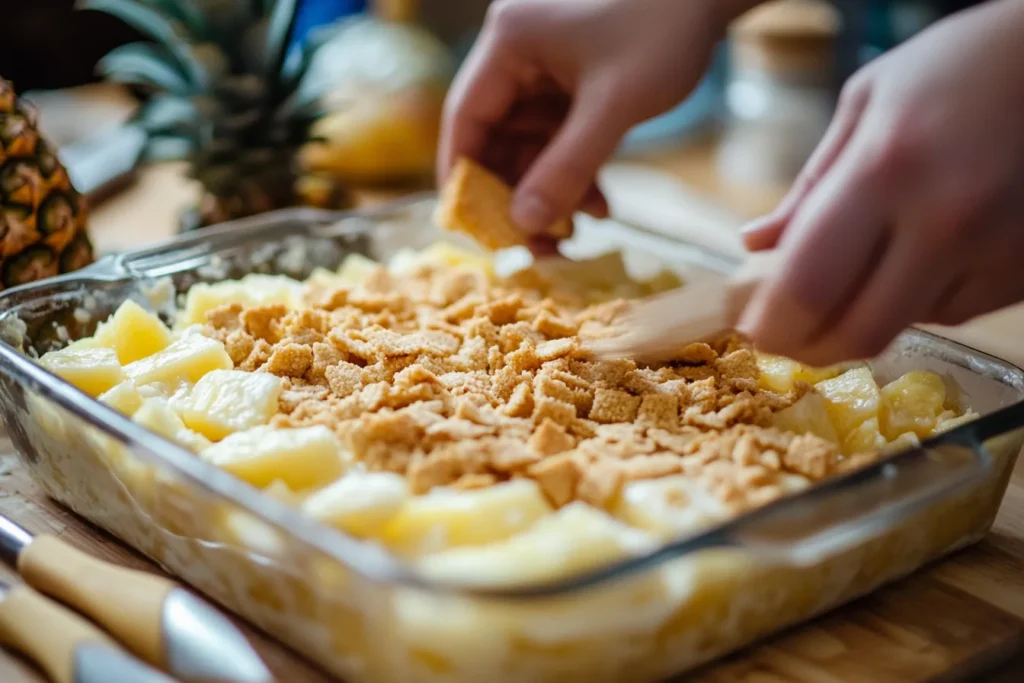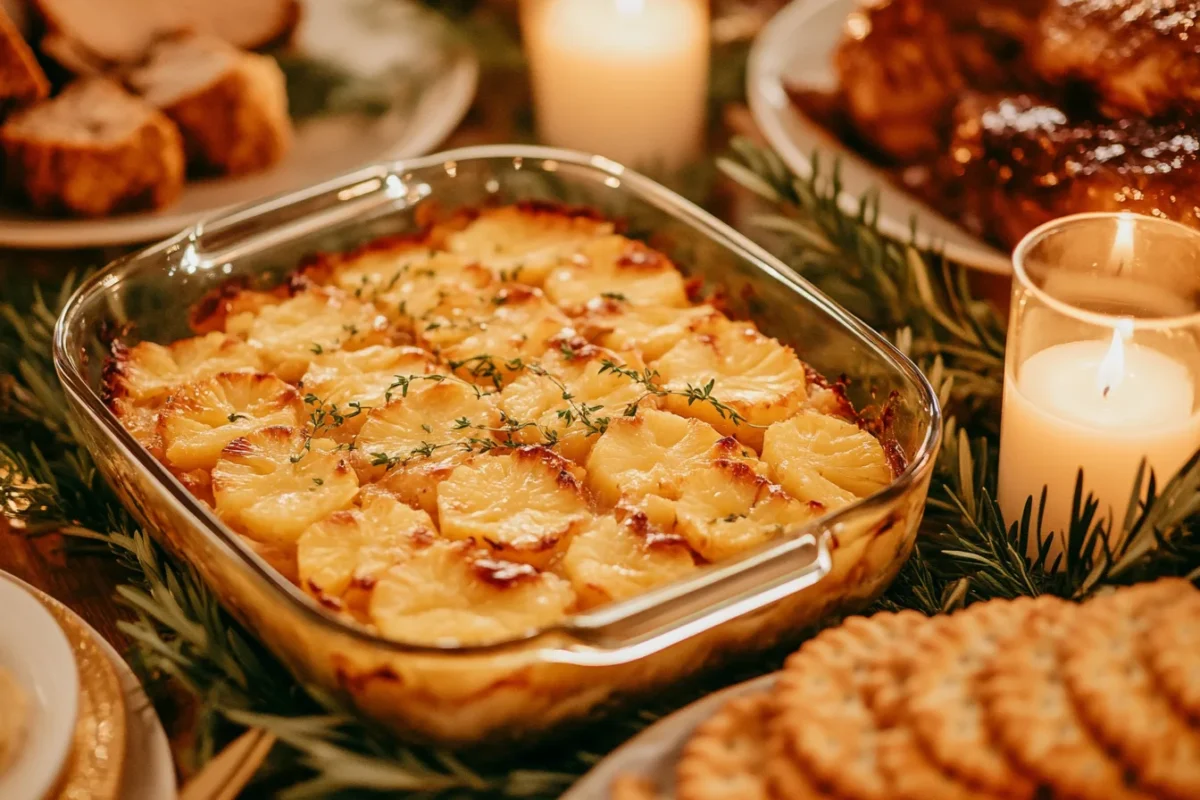Pineapple casserole is a quirky yet beloved dish, especially in the Southern United States, where it has become a staple during the holidays. Its sweet and savory combination of pineapple, cheddar cheese, and buttery crackers has intrigued food lovers for generations. But where did this unique dish originate? How did it evolve into a Southern classic?
In this article, we’ll explore the pineapple casserole origin, tracing its history from the rise of canned pineapple in the early 20th century to its modern-day presence at Southern holiday tables. We’ll break down the ingredients, cultural significance, and controversies surrounding this one-of-a-kind dish. By the end, you’ll have a deeper appreciation for this holiday favorite—and perhaps feel inspired to whip up a batch yourself!
Introduction to Pineapple Casserole
What is Pineapple Casserole?
Pineapple casserole is a Southern comfort dish blending sweet, tangy pineapple with savory cheddar cheese and a crispy, buttery cracker topping—usually made with Ritz crackers. This intriguing combination might raise eyebrows, but one bite of this sweet-savory masterpiece, and you’ll understand its charm.
Though it sounds more like a dessert, pineapple casserole is often served as a side dish during holiday feasts. It’s particularly popular at Thanksgiving, Christmas, and Easter, complementing ham, turkey, or even roast beef. The contrast between the rich, cheesy layers and the sweet pineapple creates a taste sensation that’s both nostalgic and comforting.
Why the Curiosity About Its Origin?
The pineapple casserole origin sparks curiosity because of its unusual ingredient combination. How did pineapple, a tropical fruit, become a Southern staple? Was it a product of culinary experimentation, or does its history run deeper?
This dish reflects the fusion of Southern cooking traditions with the rise of canned pineapple in the early 20th century. Canned goods transformed home cooking, making tropical fruits accessible across the U.S., especially in regions where fresh fruit was harder to come by.
Pineapple casserole represents more than just a quirky recipe—it’s a story of cultural adaptation, convenience, and the sweet-savory balance that Southern cuisine loves to celebrate. Understanding its roots offers insight into the evolution of American home cooking and why this dish continues to captivate hearts and palates today.
The Origins of Pineapple Casserole
Historical Context of Pineapple Usage in Cooking
The pineapple casserole origin can be traced back to the early 20th century, a time when canned pineapple was revolutionizing home cooking. Before canned goods became widespread, tropical fruits were rare and expensive in most parts of the United States. However, when James Dole began canning pineapple in Hawaii in the early 1900s, it quickly transformed the culinary landscape.
Suddenly, pineapple was affordable, shelf-stable, and easily incorporated into a range of recipes. This marked the beginning of pineapple’s journey into both savory and sweet dishes. Pineapple upside-down cake became a sensation in the 1920s, further popularizing the fruit in American kitchens. With its sweet-tart flavor, pineapple easily complemented richer dishes—paving the way for the creation of pineapple casserole as a balance to savory holiday spreads.

The Introduction of Canned Pineapple to the U.S.
The canned pineapple craze began around 1901, thanks to the efforts of the Dole Hawaiian Pineapple Company. James Dole’s mission was simple: make tropical fruits widely available across the U.S. The breakthrough of canning technology allowed the sweet fruit to travel far from the Hawaiian plantations to dinner tables nationwide.
By the 1920s, canned pineapple was not just a novelty but a kitchen staple. Recipe booklets, often distributed by Dole and other companies, showcased creative ways to use pineapple. Pineapple casseroles started appearing in Southern cookbooks, blending the region’s love for comfort foods with the convenience of canned fruit.
This period also saw the rise of Southern cuisine, which often incorporated sweet and savory combinations. Pineapple paired perfectly with ham, leading to the creation of glazed hams and eventually pineapple casseroles as side dishes for festive gatherings.
Internal Link Opportunity: For a delicious twist on traditional pineapple casserole, check out this pineapple casserole recipe.
The Evolution of Pineapple Casserole
From Traditional Southern Dish to Holiday Staple
Over time, pineapple casserole became deeply rooted in Southern holiday traditions. The dish, with its sweet pineapple chunks, melty cheddar cheese, and buttery cracker topping, offered a balance of flavors that made it perfect for Thanksgiving, Christmas, and Easter feasts.
While its roots are traced to canned pineapple’s popularity, its lasting fame comes from its ability to pair with rich, savory dishes like honey-glazed ham and roast turkey. The pineapple casserole origin evolved as families passed the recipe down through generations, each adding their own twist with ingredients like cinnamon, nutmeg, or even marshmallows.
Role of Pineapple Casserole in Southern Cuisine
Why did the South embrace this dish so fully? Southern cooking has long celebrated contrast—from cornbread with chili to sweet potato casserole. The combination of sweet pineapple and sharp cheddar fits this culinary tradition perfectly.
Moreover, pineapple casserole became a symbol of Southern hospitality. Its simple ingredients and easy preparation made it ideal for feeding a crowd. The blend of cheese, fruit, and crunchy crackers provided a memorable side dish for family gatherings, church potlucks, and holiday dinners.
The dish remains a cherished tradition across the South, often served alongside ham, green bean casserole, and cranberry sauce. Its adaptability also means you can find modern variations using cream cheese, breadcrumbs, or even a gluten-free version for health-conscious eaters.
Ingredients and Recipe Evolution

Original Ingredients and Recipe Composition
The pineapple casserole origin is closely tied to the early versions of the dish, which featured simple, pantry-friendly ingredients. The core recipe includes:
- Canned pineapple chunks or tidbits for sweetness and texture
- Shredded cheddar cheese to add a savory contrast
- Buttery crackers (often Ritz) for a crispy, salty topping
- Granulated sugar for an extra touch of sweetness
- Melted butter to bind the topping together
This blend of sweet pineapple, cheese, and crunchy crackers creates a balance of flavors that has kept the dish popular for generations. The recipe’s simplicity, relying on common pantry staples, made it an ideal choice for last-minute gatherings and potlucks.
Modern Variations and Ingredient Adjustments
Over time, the pineapple casserole origin evolved with home cooks adding their own creative spins. While the classic ingredients remain widely used, modern twists often include:
- Cream cheese for a richer, creamier base
- Breadcrumbs instead of crackers for a finer topping
- Brown sugar for a deeper, caramel-like sweetness
- Cinnamon or nutmeg for a hint of spice
- Fresh pineapple instead of canned for a more natural taste
Some variations have even turned pineapple casserole into a dessert, with marshmallows or sweet cream added for extra indulgence. The versatility of the dish keeps it adaptable to different palates, making it perfect for both holiday dinners and everyday meals.
For a step-by-step guide on preparing a delicious version, check out this pineapple casserole recipe.
The Cultural Significance of Pineapple Casserole
Pineapple Casserole in Southern Holiday Traditions
The pineapple casserole origin has deep cultural roots in the Southern U.S., where it has become a holiday staple. This dish’s popularity skyrocketed because of its perfect pairing with savory mains, such as baked ham, roast turkey, and pork loin.
In Southern homes, the dish isn’t just food—it’s a symbol of tradition and comfort. Families often pass down their pineapple casserole recipes through generations, with slight adjustments reflecting personal preferences. Its role on the holiday table has become so iconic that it frequently appears alongside classics like sweet potato casserole and green bean casserole.
The combination of sweet pineapple, buttery crackers, and cheese mirrors the Southern love for contrasting flavors, making it a natural fit for festive meals.
Culinary Symbolism and Regional Identity
The pineapple casserole origin also ties back to the Southern tradition of blending sweet and savory elements in dishes. Southern cuisine frequently pairs fruits with meats—think glazed ham with pineapple rings or cranberry sauce with turkey. This contrast not only enhances the dining experience but also reflects the region’s resourceful use of available ingredients.
Moreover, the casserole’s use of canned pineapple highlights the historical influence of post-World War II convenience foods. At the time, canned goods were seen as a modern innovation, making dishes like pineapple casserole both practical and celebratory.
Beyond its taste, the dish fosters a sense of togetherness. Whether served at church potlucks, Thanksgiving feasts, or Christmas dinners, it’s a dish that brings people together, sparking conversations and sharing memories.
Why Pineapple Casserole Became Popular
Ease of Preparation and Canned Pineapple Influence
The pineapple casserole origin is closely tied to the rise of canned pineapple in American kitchens during the early 20th century. One reason for its popularity is its sheer simplicity. With just a few affordable, shelf-stable ingredients—like canned pineapple, cheese, and crackers—this dish can be assembled in minutes.
During the post-World War II era, canned goods were embraced for their convenience and long shelf life. Families could prepare delicious meals without the need for fresh ingredients, making pineapple casserole ideal for last-minute gatherings. The dish’s minimal prep time, combined with its rich flavor profile, made it a hit for busy households.
Additionally, the canned pineapple trend, promoted heavily by the Dole Pineapple Company, introduced tropical flavors into everyday cooking. Its use in both savory dishes and desserts solidified pineapple’s place in the American culinary scene.
Sweet-Savory Flavor Profile Appeal
Another key factor in the pineapple casserole origin gaining traction is its unique sweet-savory flavor balance. The combination of sweet pineapple chunks, sharp cheddar cheese, and a buttery cracker crust offers a contrast that feels indulgent yet balanced.
This harmony of flavors pairs beautifully with rich holiday meats like baked ham and roast turkey, making it a go-to side dish for Thanksgiving, Christmas, and Easter celebrations. The crunchy, buttery topping adds texture, while the cheese creates a creamy, savory bite that perfectly offsets the fruit’s sweetness.
Its nostalgic taste and crowd-pleasing appeal have helped solidify pineapple casserole as a staple in many Southern households, where the love for sweet-savory dishes runs deep.
Controversies and Misconceptions
Criticism for the Sweet-Savory Mix
Despite its popularity, the pineapple casserole origin has not been without its critics. Some food purists question the sweet-savory combination, arguing that pineapple and cheese should remain separate in the kitchen.
The bold contrast of sweet fruit paired with sharp cheddar may not suit every palate. Critics often compare it to other polarizing dishes, like Hawaiian pizza, where pineapple meets savory ingredients. However, this clash of flavors is precisely what many fans find appealing—it’s unexpected yet deliciously balanced.
Others have critiqued its use of processed ingredients, especially the reliance on canned pineapple and packaged crackers. However, defenders argue that the simplicity of the original recipe is part of its charm and historical significance.
Defending Pineapple Casserole as a Culinary Classic
Despite the debate, many continue to celebrate the pineapple casserole origin as a symbol of Southern hospitality and comfort food. Its rich history, ease of preparation, and unique flavor profile have made it a lasting favorite on holiday tables across generations.
Fans of the dish highlight its versatility, pointing out how it can be adapted with fresh pineapple, gluten-free crackers, or even a spicier cheese blend for a modern twist.
Ultimately, pineapple casserole endures because it represents more than just a side dish—it tells a story of culinary creativity, family traditions, and the enduring appeal of sweet and savory harmony.
FAQs About Pineapple Casserole
What is the Origin of Pineapple Casserole?
The pineapple casserole origin can be traced back to the early 20th century, during the rise of canned pineapple as a household staple. Its roots are tied to the popularity of canned fruit introduced by the Dole Pineapple Company, making tropical fruits accessible across the United States. Southern home cooks embraced the fruit’s sweetness, blending it with savory cheese and buttery crackers to create a dish that balanced flavor contrast perfectly.
Why is Pineapple Casserole Popular in the South?
The South has long embraced dishes combining sweet and savory flavors, making pineapple casserole a natural fit. The dish pairs beautifully with rich holiday meats like glazed ham and roast turkey, making it a staple for celebrations. Its easy preparation and few ingredients made it especially appealing for large gatherings and potluck dinners.
What Are Common Variations of Pineapple Casserole?
The classic version includes canned pineapple, cheddar cheese, buttery crackers, and sugar. However, modern versions have introduced creative twists, including:
- Cream cheese for extra richness
- Breadcrumbs instead of crackers
- Brown sugar for deeper sweetness
- Fresh pineapple instead of canned
These variations allow home cooks to personalize the dish while maintaining the essence of the original recipe.
Is Pineapple Casserole a Dessert or a Side Dish?
Surprisingly, pineapple casserole often serves as a side dish, especially during holidays. Its sweet-salty balance makes it ideal next to savory dishes. However, some modern versions, with extra sugar and marshmallows, push it closer to a dessert.
Conclusion
The Lasting Legacy of Pineapple Casserole
The pineapple casserole origin is more than just a culinary footnote—it’s a reflection of American food history, shaped by the rise of canned pineapple and the Southern tradition of flavor contrast. Its unique mix of sweet pineapple, sharp cheese, and a buttery topping has kept it a holiday favorite for generations.
Why It Remains a Favorite Today
Pineapple casserole endures because it offers a perfect balance of flavors, blending sweet, savory, and crunchy textures in every bite. Its simplicity, versatility, and nostalgic appeal make it a go-to dish for holiday tables and potluck gatherings. Whether served as a side for Thanksgiving ham or reimagined as a dessert, its place in Southern cuisine is secure.
Would you like me to compile the full article for you or make any final adjustments?
Nutritional Information of Pineapple Casserole
Understanding the nutritional profile of pineapple casserole is essential, especially for those mindful of their diet. The dish, while delicious and comforting, tends to be high in sugar and fat due to its cheese, crackers, and canned pineapple components.
Here’s the approximate nutritional breakdown for a standard pineapple casserole per 100g serving:
| Nutrient | Amount (per 100g) |
|---|---|
| Calories | 210 kcal |
| Carbohydrates | 28g |
| Sugar | 22g |
| Protein | 4g |
| Fat | 9g |
| Saturated Fat | 5g |
| Sodium | 250mg |
| Fiber | 1g |
Calories: A typical serving provides moderate calories, making it a rich side dish best enjoyed occasionally.
Carbohydrates & Sugar: The sugar content is high due to the canned pineapple and added sugar.
Fat & Sodium: The dish contains notable amounts of saturated fat and sodium due to the cheese and buttery crackers.
Protein: Offers a small protein boost from the cheese.
While pineapple casserole can be enjoyed as part of a balanced diet, portion control is key due to its high sugar and fat content. Would you like me to add more health-conscious variations of the recipe?

